Abstract
The relevance of the research problem is due to the identification of the level of development and features of the formation of environmental culture of university students, as well as the correlation of this level with the level of self-esteem of students in the formation of environmental culture. 156 students of Moscow Humanitarian University and Magnitogorsk State Technical University named after G. Nosov took part in the study. Questioning shows a positive relation between the level of formation of ecological knowledge, the relation to the nature and ecological activity and level of development of components of ecological culture. Thus, students with a low level of environmental knowledge have a low level of environmental education. Students who have not shown interest in nature have a low level of environmental awareness. The revealed low activity in the field of ecological activity leads to a low level of interest in it. In contrary, students with a high level of development of these indicators have a high level of formation of environmental knowledge, as well as interest in relevant activities. The respondents have an adequate self-assessment of the level of development of ecological culture. The data obtained while diagnosing of students' self-esteem indicators coincide with the indicators revealed in the process of research of the level of development of their ecological culture. The obtained results can be used in the future in the development of special programs, models, as well as technologies for the formation of environmental culture among students of the university.
Keywords: Components of ecological cultureecological cultureself-assessment
Introduction
To date, teachers have accumulated a wealth of experience in the formation and development of environmental culture of the younger generation. Fukami and Wardle (2005), Gruner (2007), Hammermann (1980), Lucas (1972), Odum and Odum (1953), Sousa (1984) and Wilson (1994) made a great contribution to the formation of ecological education.
Today all over the world there is an increase in the number of researchers whose interests affect the problem of formation of ecological culture. Thus, in the United States for the period from 1971 to 1980 394 theses on environmental issues were defended, in the period from 1981 to 1990 – 307 similar theses, from 1991 to 2000-1392 theses (Dillon, Brody, & Stevenson, 2013).
The best works in the field of environmental education were analyzed, summarized and systematized, resulting in a collection of dissertations on environmental topics for the period from 1970 to 2000 (Marcinkowski et al., 2013). This study was conducted by the research Commission of the North American Association for Environmental Education (NAAEE) with the support of the U.S. Educational Resources Information Center (ERIC), which is located at Ohio State University.
A significant contribution to the development of University environmental-oriented education was made by Bainer, Cantrell, and Barron (1997) and Engleson (1985). Engleson (1985) was the first to develop an eight-step method of forming ecological culture. His colleagues Bainer, Cantrell, and Barron, (1997) in the process of environmental education at the University proposed to apply an integrated approach, including interdisciplinarity, transdisciplinarity and multidisciplinarity.
The problem of formation of ecological culture and its components is well studied in modern Russian pedagogical literature. Its motivational-value component was considered in the work of Nesgoraeva and Saveljev (2009). The study of Abdrashitova (2013) is devoted to the moral and aesthetic components of ecological culture; the value component is revealed in the article by Ryabova (2012); the cognitive component of ecological culture was considered in the work of Nesgoraeva and Saveljev (2010); the activity component is revealed by Polyanskaya and Khitsova (2015).
Problem Statement
We have made the following assumptions:
1. There is a relationship between the level of formation of environmental knowledge, attitude to nature and environmental activities of students, which affects the level of development of environmental consciousness, environmental activities and environmental education.
2. The level of self-assessment of students in relation to the development of environmental culture coincides with the level of development of environmental culture of students identified in the study.
Research Questions
In our study, we rely on the position that the study of any cultural phenomenon requires the allocation of its functions. In the philosophical and social sense, function refers to the role that a particular social institution performs in relation to the needs of the social system. Accordingly, the functions of culture should be understood as the role it plays in the life of society (Benin, Vasilina, & Zhukova, 2014).
The research is also based on the work in the field of identification of components of ecological culture, published by Fortunatov (2015), Sitarov and Urekeshova (2017). In the course of the research conducted by the authors, the following components of ecological culture were identified: ecological knowledge, ecological-like activities, as well as values and relationships with the surrounding socio-natural environment. These components were used by us for selection of diagnostic methods of formation of ecological culture of University students. This actually served as the basis for the organization and conduct of the study, the results of which are presented in this article.
Purpose of the Study
The aim of the work is to study the level of formation of environmental knowledge, attitude to nature and environmental activities of University students and the level of development of their ecological consciousness, environmental activities and environmental education.
Research Methods
In the course of the study, we used modernized diagnostic techniques designed to identify the level of development of environmental culture: "Diagnosis of the level of environmental culture of the individual" by Kashlev and Glazachev (2000); test-questionnaire "Environmental culture of students" by Asafova (2002); test-questionnaire "Self-assessment of environmental culture" by Nogteva and Lushnikov (2004).
Findings
To answer the first assumption, the students were asked to answer the questions of two methods of diagnosis of the level of development of ecological culture: Kashlev and Glazachev (2000) and Asafova (2002). Let us dwell on their analysis in more detail.
"Diagnostics of the level of ecological culture of personality" by Kashlev and Glazachev (2000). In the process of identifying the level of environmental knowledge (figure
The indicators regarding the value of nature and attitude to nature (figure
Environmental performance indicators (figure
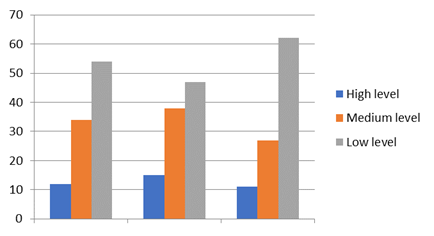
In the process of identifying the level of environmental education (figure
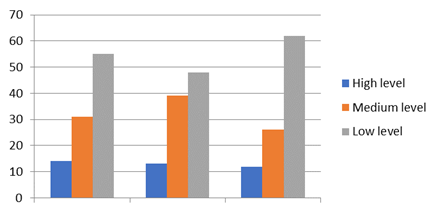
In the study of the level of environmental awareness (figure
During the study of the level of interest in environmental activities (figure
Analyzing the data that were obtained in the process of applying these techniques, it should be noted that the level of formation of environmental knowledge, attitude to nature and environmental activities directly affect the level of development of environmental consciousness, interest in environmental activities and environmental education. Thus, students with a low level of environmental knowledge have a low level of environmental education. Students who showed no interest in the relationship to nature have a low level of environmental consciousness. And the revealed low activity in the field of ecological activity leads to a low level of interest in it. Conversely, students with a high level of development of these indicators have a high level of formation of environmental knowledge and education, as well as interest in activities.
Summing up the results of our research with the use of methods to identify the development of ecological culture by Asafova (2002), Kashlev and Glazachev (2000), it should be noted that 12% of respondents (figure
34% of respondents (figure
And 54% of the surveyed students (figure
To validate the second of the assumptions made by us and associated with the coincidence of the level of self-esteem of students in relation with the development of ecological culture with the development level of ecological culture of students, identified in the research process, the test "self-assessment of an environmental culture" by Nogteva and Lushnikov (2004) was applied .
In the process of studying the level of ecological and value knowledge (figure
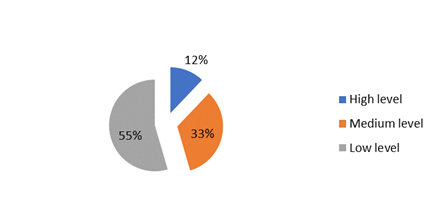
In the study of the level of environmental-value relations (figure
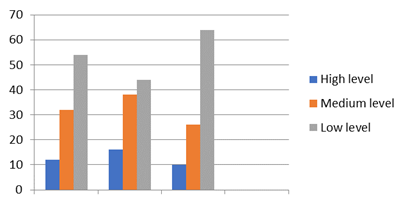
In the course of the study of the level of environmental-value activity (figure
Based on the results obtained, we identified the following level of formation of ecological culture among students (figure
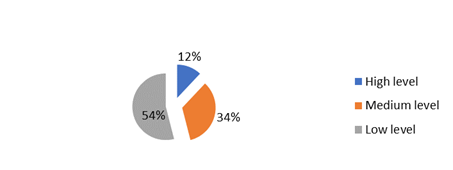
12% of respondents had a high level of formation of ecological culture (figure
34% of respondents showed an average level of formation of ecological culture (figure
The majority of the students surveyed (54%) have a low level of formation of ecological culture (figure
Conclusion
Thus, our assumption that the majority of the surveyed students have an adequate level of self-esteem in relation to the development of environmental culture is confirmed. The data obtained in the process of diagnostics of ecological culture and revealed in the process of self-assessment of students coincide with the indicators revealed in the process of research.
Summing up the above, it should be noted that the low level of development of elements of ecological culture leads to low indicators in respect of elements dependent on it. It should be noted that the level of formation of ecological culture among students is rather low, which suggests the need for its further formation and development.
References
- Abdrashitova, N. V. (2013). Model formirovaniya nravstvennogo i esteticheskogo komponentov ekologicheskoj kultury studentov [Model of formation of moral and aesthetic components of ecological culture of students]. Vestnik Kazanskogo gosudarstvennogo universiteta kultury i iskusstv, 2, 95-100. Retrieved from https://www.elibrary.ru/item.asp?id=20289709
- Asafova, E. V. (2002). Vospitanie i diagnostika razvitiya ekologicheskoj kultury studentov [Formation and diagnostics of students' ecological culture development]. Report on scientific and research work "Development of upbringing system model in a higher educational establishment (in the Kazan State University)". Retrieved from http://old.kpfu.ru/infres/nikolaev/2002/gl2_3_3.htm
- Bainer, D. L., Cantrell, D., & Barron, P. (1997). Professional Development of Environmental Educators through Partnerships. Paper presented at the Annual Meeting of the North American Association for Environmental Education, 8, 15-19.
- Benin, V. L., Vasilina, D. S., & Zhukova, E. D. (2014). Kulturologicheskaya kompetentnost subjekta professionalno-pedagogicheskoj deyatelnosti: ucheb. posobie dlya studentov i prepodavatelej vysshej shkoly [Culturological competence of the subject of professional and pedagogical activity: manual for students and teachers of higher education]. Moscow: Izd-vo Pero.
- Dillon, J., Brody, M., & Stevenson, R. B. (2013). International Handbook of Research on Environmental Education. NY and London: Routledge.
- Engleson, D. C. (1985). A guide to curriculum planning in environmental education. Environmental education curriculum development task force. Bulletin, 6094, 103.
- Fortunatov, A. A. (2015). Funktsii ekologicheskoj kultury: analiz opredelenij [Functions of ecological culture: analysis of definitions]. Znanie. Ponimanie. Umenie, 4, 110-117.
- Fukami, T., & Wardle, D. A. (2005). Long-term ecological dynamics: reciprocal insights from natural and anthropogenic gradients. Proceedings of the Royal Society of London, Series B. Biological Sciences, 272.
- Gruner, D. S. (2007). Geological, ecosystem development, and local resource constraints on arthropod community structure in the Hawaiian Islands. Biological journal of the Linnean Society, 90, 551-570.
- Hammermann, W. M. (1980). Fifty years of resident outdoor education: 1930-1980: Its impact on American education. Martinsville, IN: American Camping Association.
- Kashlev, S. S., & Glazachev, S. N. (2000). Pedagogicheskaya diagnostika ekologicheskoj kultury uchashchihsya: Posobie dlya uchitelya [Pedagogical diagnostics of the ecological culture of students: teacher's manual]. Moscow: Gorizont.
- Lucas, A. M. (1972). Environment and environmental education: Conceptual issues and curriculum implications (Doctoral dissertation). Retrieved from https://eric.ed.gov/?id=ED068371
- Marcinkowski, T., Bucheit, J., Spero, V., Linsenbardt, C., Engelhardt, J., Stadel, M., …, & Guzmon, K. (2013). 5: Selected trends in thirty years of doctoral research in environmental education in Dissertation Abstracts International from collections prepared in the U.S. In R. Stevenson, M. Brody, J. Dillon, & A. Wals (Eds.), International handbook of research on environmental education (pp. 45-62). Washington, DC: American Educational Research Association and Routledge.
- Nesgoraeva, N. S., & Saveljev, V. G. (2009). Motivatsionno-tsennostnyj komponent v ekologicheskoj kulture studentov vuza [Motivational and value component in the ecological culture of University students]. Omskij nauchnyj vestnik, 5, 143-146.
- Nesgoraeva, N. S., & Saveljev, V. G. (2010). Formirovanie kognitivnogo komponenta ekologicheskoj kultury studentov vuza v protsesse praktiko-orientirovannoj obrazovatelnoj deyatelnosti [Formation of cognitive component of ecological culture of University students in the process of practice-oriented educational activities]. Vestnik Zabajkalskogo gosudarstvennogo universiteta, 1, 39-44.
- Nogteva, E. Ju., & Lushnikov, I. D. (2004). Razvitie ekologicheskoj kultury uchashchihsya [Development of the ecological culture of students]. Vologda: IZ Viro.
- Odum, E. P., & Odum, H. T. (1953). Fundamentals of ecology. Philadelphia: W.B. Saunders Company.
- Polyanskaya, E. I., & Khitsova, L. N. (2015). Ekomuzej kak sposob formirovaniya deyatelnostnogo komponenta ekologicheskoj kultury [Eco-museum as a way to form the activity component of ecological culture]. Vestnik universiteta, 2, 302-305.
- Ryabova, S. S. (2012). Tsennostnoe otnoshenie k prirode kak komponent ekologicheskoj kultury [Value attitude to nature as a component of ecological culture]. Izvestiya Rossijskogo gosudarstvennogo pedagogicheskogo universiteta im. A.I. Gertsena, 4, 245-250.
- Sitarov, V. A., & Urekeshova, L. (2017). Students ecological awareness development on geography lesion in the Republic of Kazakhstan. Regional science inquiry, 2, 187-196.
- Sousa, W. P. (1984). The role of disturbance in natural communities. Annual review of ecology and systematics, 15, 353-391.
- Wilson, R. A. (1994). Environmental education at the early childhood level. Washington, DC: North American association for environmental education.
Copyright information

This work is licensed under a Creative Commons Attribution-NonCommercial-NoDerivatives 4.0 International License.
About this article
Publication Date
15 November 2020
Article Doi
eBook ISBN
978-1-80296-092-1
Publisher
European Publisher
Volume
93
Print ISBN (optional)
-
Edition Number
1st Edition
Pages
1-1195
Subjects
Teacher, teacher training, teaching skills, teaching techniques, special education, children with special needs, computer-aided learning (CAL)
Cite this article as:
Fortunatov, A., & Benin, V. (2020). University Students Level Of Development And Features Of Environmental Culture Formation Analysis. In I. Murzina (Ed.), Humanistic Practice in Education in a Postmodern Age, vol 93. European Proceedings of Social and Behavioural Sciences (pp. 1031-1039). European Publisher. https://doi.org/10.15405/epsbs.2020.11.107

